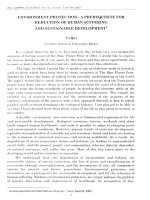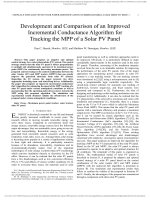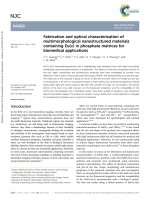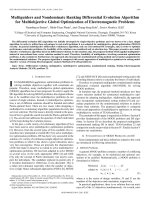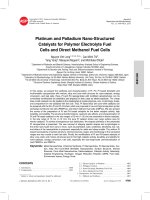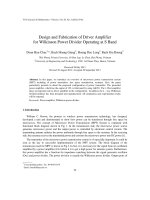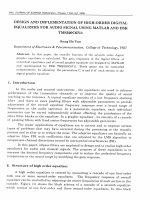DSpace at VNU: Unsupervised and semi-supervised clustering for large image database indexing and retrieval
Bạn đang xem bản rút gọn của tài liệu. Xem và tải ngay bản đầy đủ của tài liệu tại đây (520.38 KB, 6 trang )
Unsupervised and semi-supervised clustering for
large image database indexing and retrieval
Lai Hien Phuong∗† , Muriel Visani∗ , Alain Boucher† and Jean-Marc Ogier∗
∗ L3I,
Universit´e de La Rochelle, 17042 La Rochelle cedex 1, France
Email: hien ,
,
† IFI, MSI team; IRD, UMI 209 UMMISCO; Vietnam National University, 42 Ta Quang Buu, Hanoi, Vietnam
Email:
Abstract—The feature space structuring methods play a very
important role in finding information in large image databases.
They organize indexed images in order to facilitate, accelerate
and improve the results of further retrieval. Clustering, one
kind of feature space structuring, may organize the dataset into
groups of similar objects without prior knowledge (unsupervised
clustering) or with a limited amount of prior knowledge (semisupervised clustering). In this paper, we present both formal and
experimental comparisons of different unsupervised clustering
methods for structuring large image databases. We use different image databases of increasing sizes (Wang, PascalVoc2006,
Caltech101, Corel30k) to study the scalability of the different
approaches. Moreover, a summary of semi-supervised clustering
methods is presented and an interactive semi-supervised clustering model using the HMRF-kmeans is experimented on the
Wang image database in order to analyse the improvement of
the clustering results when user feedbacks are provided.
I. I NTRODUCTION
The traditional content-based image retrieval relies in general on two phases. The first phase is to extract the feature
vectors of all the images in the database. The second phase is
to compare the feature vector of the query image to that of all
the other images in the database for finding the nearest images.
With the development of many large image databases, the
exhaustive search is not generally compatible. Feature space
structuring methods (clustering, classification) are therefore
necessary for organizing feature vectors of all images in order
to facilitate and accelerate further retrieval.
Clustering aims to split a collection of data into groups
(clusters) so that similar objects belong to the same group and
dissimilar objects are in different groups. Because the feature
vectors only capture low level information such as color, shape
or texture of image (global descriptor) or of a part of an image
(local descriptor), there is a semantic gap between high-level
semantic concepts expressed by the user and these low-level
features. The clustering results are therefore generally different
from the intent of the user. Our final work aims involving the
user into the clustering phase so that the user could interact
with the system in order to improve the clustering results
(the user may split or group some clusters, add new images,
etc.). With this aim, we are looking for clustering methods
which can be incrementally built in order to facilitate the
insertion or deletion of images. The clustering methods should
also produce a hierarchical cluster structure where the initial
clusters may be easily merged or split. It can be noted that
the incrementality is also very important in the context of
very large image databases, when the whole dataset cannot
be stored in the main memory. Another very important point
is the computational complexity of the clustering algorithm,
especially in an interactive context where the user is involved.
In the case of large image database indexing, we may
be interested in traditional clustering (unsupervised) or semisupervised clustering. While no information about the ground
truth is provided in the case of unsupervised clustering, a
limited amount of knowledge is available in the case of semisupervised clustering. The provided knowledge may consist in
class labels (for some objects) or pairwise constraints (mustlink or cannot-link) between objects.
Some general surveys of unsupervised clustering techniques
have been proposed in the literature [1], [2]. Jain et al. [1]
presents an overview of different clustering methods and gives
some important applications of clustering algorithms such as
image segmentation or object recognition, but they did not
present any experimental comparison of these methods. A
well-researched survey of clustering methods is presented in
[2], including analysis of different clustering methods and
some experimental results, but the experiments are not specific
to image analysis. There are three main contributions in this
paper. First, we analyze the advantages and drawbacks of
different unsupervised clustering methods in a context of
huge masses of data where incrementality and hierarchical
structuring are needed. Second, we experimentally compare
four of these methods (global k-means [3], AHC [4], SR-tree
[5] and BIRCH [6]) with different real image databases of increasing sizes (Wang, PascalVoc2006, Caltech101, Corel30k)
(the number of images going from 1000 to 30000) to study
the scalability of different approaches when the size of the
database is increased. Third, we present some semi-supervised
clustering methods and propose a preliminary experiment of an
interactive semi-supervised clustering model using the HMRFkmeans (Hidden Markov Random Fields kmeans) clustering
[33] on the Wang image database in order to analyse the
improvement of the clustering process when user feedbacks
are provided.
This paper is structured as follows. Section II presents both
formal and experimental comparisons of some unsupervised
978-1-4673-0309-5/12/$31.00 ©2012 IEEE
clustering methods. Different semi-supervised clustering methods are described in section III. A preliminary experiment of
an interactive semi-supervised clustering model is proposed in
section IV. Section V presents some conclusions and further
work.
II. U NSUPERVISED CLUSTERING METHODS COMPARISONS
Unsupervised clustering methods are divided into several
types:
• Partitioning methods (k-means [7], k-medoids [8], PAM
[9], CLARA [9], CLARANS [10], ISODATA [11], etc.)
partition the dataset based on the proximities of the
images in the feature space. These methods give in
general a “flat” (i.e. non hierarchical) organization of
clusters.
• Hierarchical methods (AGNES [9], DIANA [9], AHC [4],
R-tree family [5], SS-tree [5], SR-tree [5], BIRCH [6],
CURE [12], ROCK [13], etc.) organize the points in a
hierarchical structure of clusters.
• Grid-based methods (STING [14], WaveCluster [15],
CLICK [16], etc.) partition a priori the space into cells
without considering the distribution of the data and then
group neighbouring cells to create clusters. The cells may
be organized in a hierarchical structure or not.
• Density-based methods (EM [17], DBSCAN [18], DENCLUE [19], OPTICS [20], etc.) aim to partition a set of
points based on their local densities. These methods give
a “flat” organization of clusters.
• Neural network-based methods (LVQ [21], SOM [21],
ART [22], etc.) aim to group similar objects using the
network and represent them by a single unit (neuron).
A. Formal comparison
As stated in section I, in our context, we need the clustering
methods producing a hierarchical cluster structure. Among
all five types of unsupervised clustering, the hierarchical
methods always produce a hierarchical structure. We thus
compare formally in Table I different hierarchical clustering
methods (AHC, BIRCH, CURE, R-tree, SS-tree, SR-tree)
towards some of the most popular methods of other types: kmeans (partitioning methods), STING (grid-based methods),
EM (density-based methods) and SOM (neural network-based
methods). Different criteria (complexity, appropriateness to
large databases, incrementality, hierarchical structure, data
order dependence, sensitivity to outliers and parameter dependence) are used for the comparison.
K-means is not incremental, it does not produce any hierarchical structure. K-means is independent of the processing
order of the data and does not depend on any parameter.
Its computational and storage complexities can be considered
as linear to the number of objects, it is thus suitable to
large databases. The hierarchical methods (in italics) organize
data in a hierarchical structure. Therefore, by considering the
structure at different levels, we can obtain different numbers
of clusters, which is useful in the context where users are
involved. AHC is not incremental and it is not suitable to large
databases because its computational and storage complexities
are very high (at least quadratic to the number of elements).
BIRCH, R-tree, SS-tree and SR-tree are by nature incremental
because they are built by adding incrementally records. They
are also adapted to large databases because of their relatively
low computational complexity. CURE realizes the hierarchical
clustering using only a random subset containing Nsample
points of the database, the other points being associated to the
closest cluster. Its computational complexity is thus relatively
low and CURE is adapted to large databases. It is incremental
but the results depend much on the random selection of the
samples and the records which are not in this random selection
have to be reassigned whenever the number of clusters k is
changed. CURE is thus not suitable to the context where
users are involved. STING, the grid-based method, divides
the feature space into rectangular cells and organizes them
according to a hierarchical structure. With a linear computational complexity, it is adapted to large databases. It is also
incremental. However, as STING is used for spatial data and
its attribute-dependent parameters have to be calculated for
each attribute, it is not suitable to high dimensional data such
as feature image space. Moreover, when the space is almost
empty, hierarchical methods perform better than grid-methods.
The EM density-based method is suitable to large databases
because of its low computational complexity and is able to
detect outliers. But it is very dependent on the parameters and
is not incremental. The original EM method does not produce
any hierarchical structure, while some other extensions [23],
[24] can be an estimator of hierarchical models. SOM groups
similar objects using a neural network which output layer
contains neurons representing the clusters. SOM depends on
initialization values and on the rules of influence of a neuron
on its neighbors. It is incremental as the weight vectors of the
output neurons can be updated when new data arrive. SOM
is also adapted to large database, but it does not produce any
hierarchical structure. We can conclude from this analysis that
the methods BIRCH, R-tree, SS-tree and SR-tree are the most
suitable to our context.
B. Experimental comparison
In this section, we present an experimental comparison
of the partitioning method global k-means [3] with three
hierarchical methods (AHC [4], SR-tree [5] and BIRCH [6]).
Global k-means is a variant of the well known and widely
used k-means method. The advantage of the global k-means
is that we can automatically select the number of clusters k by
stopping the algorithm at the value of k providing acceptable
results. The other methods provide hierarchical clusters. AHC
is chosen because it is the most popular method in the
hierarchical family and there exists an incremental version
of this method. Among four methods BIRCH, R-tree, SStree, SR-tree that are most suitable to our context, we choose
BIRCH and SR-tree because SR-tree combines the advantages
of R-tree and SS-tree methods.
We compare the four selected clustering methods using dif-
TABLE I
F ORMAL COMPARISON OF DIFFERENT CLUSTERING METHODS BASED ON DIFFERENT CRITERIA . M ETHODS IN GREY ARE CHOSEN FOR EXPERIMENTAL
COMPARISON . F OR COMPLEXITY ANALYSIS , WE USE THE FOLLOWING NOTATIONS : N - NUMBER OF OBJECTS IN THE DATASET, k- NUMBER OF CLUSTERS ,
l- NUMBER OF ITERATIONS , Nsample - NUMBER OF SAMPLES CHOSEN , m- NUMBER OF TRAINING ITERATIONS , k - NUMBER OF NEURONS IN THE OUTPUT
LAYER .
Methods
Complexity
No
No
No
Sensitivity
to
outliers
Sensitive
k-means [7] (partitioning)
O(N kl)
(time)
O(N + k) (space)
AHC [4] (hierarchical)
O(N 2 logN )
O(N 2 ) (space)
Have
incremental
version
Yes
Yes
No
Sensitive
No
BIRCH [6] (hierarchical)
O(N ) (time)
Yes
Yes
Yes
Yes
Yes
No
Yes
Able to add
new points
Yes
Yes
Yes
Enable
outliers
detection
Less
sensitive
Sensitive
CURE [12] (hierarchical)
2
O(Nsample
logNsample )
(time)
O(N logN ) (time)
Yes
O(N ) (time)
Yes
Yes
Yes
No
Enable
outliers
detection
No
EM [17] (density-based)
O(N k2 l) (time)
Yes
No
No, Yes
No
Yes
SOM
[21]
network-based)
O(k N m) (time)
Yes
Yes
No
Yes
Enable
outliers
detection
Sensitive
R-tree, SS-tree, SR-tree
[5] (hierarchical)
STING [14] (grid-based)
(neural
Appropriateness
to large
database
Yes
(time)
No
ferent image databases of increasing size (Wang1 (1000 images
of 10 classes), PascalVoc20062 (5304 images of 10 classes),
Caltech1013 (9143 images of 101 classes) and Corel30k
(31695 images of 320 classes)). Towards feature descriptors,
we implement rgSIFT [25], a color SIFT descriptor that is
widely used nowadays for its high performance. We use the
color SIFT descriptor code of Koen van de Sande4 . The “Bag
of words” approach is chosen to group local features into
a single vector representing the frequency of occurrence of
the visual words in the dictionary [26]. The number of visual
words in the dictionary (also called dictionary size) is fixed to
200. Both internal (Silhouette-Width (SW) [27]) and external
measures (Rand Index [28]) are used in order to analyze
the clustering results. While internal measures are low-level
measures which are essentially numerical and unsupervised,
external measures are high-level measures which give a supervised (semantic) evaluation based on the comparison between
the clusters produced by the algorithm and the ground truth.
Figure 1 shows the result of the different clustering methods
on the different image databases of increasing sizes. The
results show that SR-tree gives the worst results on the Wang
image database, it is not used anymore on larger databases
(PascalVoc2006, Caltech101, Corel30k). The AHC method is
not used on the Corel30k image database because of the lack
of RAM memory. In fact, the AHC clustering requires a large
amount of memory when processing more than 10000 elements, while the Corel30k contains more than 30000 images.
1 />2 />3 />
Datasets/Caltech101/
4 />
Incrementality Hierarchical
structure
Data order
dependence
Global k−means
BIRCH
0.06
AHC
Parameter
Dependence
No
No
Yes
Yes
SR−tree
1
0.9
0.05
0.8
0.7
0.04
0.6
0.03
0.5
0.4
0.02
0.3
0.2
0.01
0.1
0
0
Wang
PascalVoc2006Caltech101
Corel30k
Silhouette−Width (internal measure)
Wang
PascalVoc2006Caltech101
Corel30k
Rand Index (external measure)
Fig. 1. Comparison of different unsupervised clustering methods (Global
k-means, SR-tree, BIRCH, AHC) on different image databases (Wang, PascalVoc2006, Caltech101, Corel30k) using the local feature descriptor rgSIFT
with a dictionary of size 200. Both internal measure (Silhouette-Width) and
external measure (Rand Index) are used. The higher are these measures, the
best are the results.
We can see that the internal and external measures do not
evaluate the same aspects and give very different results. The
external measures are closer to the user’s attempts. The results
show that, according to internal measures, the best method
varies from each database while BIRCH is always the best
method regardless of the size of the database according to
external measures (which are more suitable to the context
where users are involved). Moreover, in comparison to global
k-means and AHC, BIRCH is much faster, especially in the
case of the Caltech101 and Corel30k image databases (e.g the
execution time of BIRCH in the case of the Corel30k is about
400 times faster than that of the global k-means).
III. S EMI - SUPERVISED CLUSTERING METHODS
In semi-supervised clustering, some prior knowledge is
available, either in the form of class labels (for some objects)
or in the form of pairwise constraints between some objects.
Pairwise constraints specify whether two objects should be in
the same cluster (must-link constraint) or in different clusters
(cannot-link constraint). This prior knowledge is used to guide
the clustering process.
Some semi-supervised clustering methods using prior
knowledge in the form of labeled objects have been proposed in the literature: seeded-kmeans [30], constraintedkmeans [30], etc. Seeded-kmeans and constrained k-means
are based on the k-means algorithm. Prior knowledge of
these two methods is a small subset of the input database,
called seed set, containing user-specified labeled objects of
k different clusters. Rather than initializing randomly the
clustering, these two methods initialize their k cluster centers
using different partitions of the seed set. The second step of
the seeded-kmeans is to apply the k-means algorithm on the
whole database without considering the prior labels of the
objects in the seed set. In constrast, the constrained-kmeans
applies the k-means algorithm while keeping the label of userspecified objects unchanged. An interactive cluster-level semisupervised clustering was proposed in [31]. In this model,
knowledge is not provided a priori, it is progressively provided
as assignment feedbacks and cluster description feedbacks
of users after each interactive iteration. Using assignment
feedback, the user moves an object from one of the current
clusters to another. Using cluster description feedback, the
user modifies the feature vector of any current cluster, for
example, by increasing the weights of some important words
(note that this method is implemented for document analysis).
The algorithm learns from all feedbacks provided in earlier
stages to re-cluster the dataset in order to minimize the sum
of distance between points and corresponding cluster centers
while minimizing the violation of constraints corresponding to
feedbacks.
Some semi-supervised clustering methods that use prior
knowledge in the form of constraints between objects are
COP-kmeans (constrained k-means) [32], HMRF-kmeans
(Hidden Markov Random Fields Kmeans) [33], etc. In COPkmeans, each point is assigned to the closest cluster while
respecting the constraints; the clustering fails if no solution
respecting the constraints is found. In HMRF-kmeans, constraint violation is allowed with a violation cost (penalty).
The violation cost of a pairwise constraint may be either
a constant or a function of the distance between the two
points specified in the pairwise constraint. In order to ensure
the respect of the most difficult constraints, higher penalties
are assigned to violations of must-link constraints between
points that are distant. With the same idea, higher penalties
are assigned to violations of cannot-link constraints between
points which are close in the feature space. HMRF-kmeans
initializes the k cluster centers based on the user-specified
constraints and unlabeled points, as described in [33]. After the
Fig. 2. 2D interactive interface representing the results of the Wang image
database. The rectangle at the bottom right corner represents the principal
plane consisting of the two first principal axis (obtained by PCA) of the
representative images of all clusters. Each circle represents the details of a
particular cluster selected by the user.
initialization step, an iterative algorithm is applied to minimize
the objective function (which is the sum of distances between
points and corresponding centers with the penalties of violated
constraints). The iterative algorithm consists in three steps:
• E-step: Re-assign each data point to the cluster which
minimizes its contribution to the objective function.
• M-step (A): Re-estimate the cluster centers to minimize
the objective function.
• M-step (B): If the distance between points are estimated
by a parameterized distortion measure, the parameters of
the distortion measure are subsequently updated to reduce
the objective function.
IV. I NTERACTIVE SEMI - SUPERVISED CLUSTERING
EXPERIMENTATION
In this section, we present some experimental results of
an interactive semi-supervised clustering model on the Wang
image database. The initial clustering is realized without any
prior knowledge, using k-means. We implement an interactive
interface that allows the user to view the clustering results
and to provide feedbacks to the systems. Using Principal
Component Analysis (PCA), all the representative images
(one for each cluster) are presented in the principal plane
(the rectangle at the bottom right corner of Figure 2, the
principal plane consists of the two principal asis associated
with the highest eigenvalues). User can view the details of
some clusters by clicking the corresponding representative
images. In our experiments, we use the internal measure
Silhouette-Width (SW) [27] to estimate the quality of each
image in a cluster. The higher is the SW value of an image
in a cluster, the more compatible is this image for this cluster.
In Figure 2, each cluster selected by the user is represented
by a circle: the image at the center of the circle is the most
representative image (image with the highest SW value) of
this cluster; the 10 most representative images (images with
the highest SW values) are located near the center and the
10 least representative images (images with the smallest SW
values) are located near the border of a cluster. User can specify positive feedbacks and negative feedbacks (respectively
images with blue and red border in Figure 2) for each cluster.
User can also change the cluster assignment of a given image.
When an image is changed from a cluster A to a cluster B,
it is considered as a negative feedback for cluster A and a
positive feedback for cluster B. While only positive images
of a cluster are used to derive must-link constraints, both
positive and negative images are needed for deriving cannotlink constraints. After receiving feedbacks from the user, the
HMRF-kmeans is applied to re-cluster the whole dataset using
pairwise constraints derived from feedbacks accumulated from
all earlier stages. The interactive process is repeated until
the clustering result satisfy the user. Note that the distorsion
measure used in our first experimentation is the Euclidian
distance because of its simplicity and its popularity in the
image domain.
1) Experimental protocol: In order to automatically realize
the interactive tests, we implement an agent later called
“user agent” that simulates the behaviors of the user when
interacting with the system (assuming that the agent knows
all the ground truth which contains the class label of each
image). At each interactive iteration, clustering results are
returned to the user agent by the system; the agent simulates
the behaviors of the user to give feedbacks to the system.
The system then uses these feedbacks to update the clustering.
Note that the clustering results returned to the user agent are
the most representative images (one for each cluster) and their
positions in the principal plane. When the agent user views a
cluster, the 10 most and 10 least representative images of this
cluster are displayed.
For simulating the user’s behaviors, we proposed some
simple rules:
• At each iteration, the user agent chooses to view a fixed
number of c clusters.
• There are two strategies for choosing clusters by the user
agent: randomly choose c clusters, or choose iteratively
two closest clusters until having c clusters.
• The user agent determines the image class (in the ground
truth) corresponding to each cluster by the most represented class among the 21 shown images. The number
of images in this class must be greater than a threshold
M inImages. If it is not the case, this cluster can be
considered as a noise cluster.
• When there are several clusters (among chosen clusters)
that correspond to a same class, the user agent chooses
the cluster in which the images of this class are the most
numerous (among the 21 shown images of the cluster)
as the principal cluster of this class. The classes of the
other clusters are redefined as usual, but neutralizing the
images from this class.
• In each chosen cluster, all images such that the result of
the algorithm corresponds to the ground truth are positive
samples of this cluster, while the others are negative
V−measure − Scenario1
Rand Index − Scenario1
V−measure − Scenario 2
Rand Index − Scenario2
V−measure − Scenario 3
Rand Index − Scenario 3
1
0.9
0.8
0.7
0.6
0.5
0.4
0.3
0.2
0.1
0
0
2
4
6
8 10 12 14 16 18 20 22 24 26 28 30 32 34 36 38 40 42 44 46 48 50
Fig. 3. Results of the automatic test of interactive semi-supervised clustering
on the Wang image database using rgSIFT. Three scenarios and two external
measures (V-measure, Rand Index) are used. The horizontal axis specifies
interaction iterations (iteration 0 means the initial k-means without prior
knowledge).
samples of this clusters. All negative samples are moved
to the cluster corresponding to their true class in the
ground truth.
We propose three test scenarios for experiments on the
Wang image database. Note that the number of clusters k
in the clustering is equal to the number of classes (10) in
the ground truth. We set the threshold M inImages = 5
for all three scenarios. In scenarios 1 and 2, we use c = 5
clusters for interacting, while in scenario 3, we use all the
clusters (c = 10). In scenario 1, clusters are randomly chosen
(strategy 1) for interacting, while we iteratively choose the
closest clusters (strategy 2) in scenario 2.
2) Experimental results and discussions: Figure 3 presents
the results of the three previous scenarios on the Wang image
database using two external measures (Rand Index [28] and Vmeasure [29]). The external measures compare the clustering
results with the ground truth that is compatible to estimate the
quality of the interactive clustering after receiving feedbacks
from the user. The local feature descriptor rgSIFT with a
dictionary of size 200 is used for these tests. We can see
that for all these three scenarios, the clustering results are
improved after each interactive iteration, in which the system
re-clusters the dataset following the feedbacks accumulated
from the previous iterations. However, after some iterations,
the clustering results converge. This may be due to the fact
that no new knowledge is provided to the system because
the 21 images shown to the user remain unchanged. Another
strategy consisting in showing only the images that were
not previously presented to the user might be interesting.
Moreover, we can see that the clustering results converge
more quichly when the number of chosen clusters at each
iterative iteration is high (scenario 3 converges more quickly
than scenarios 1 and 2). Performing automatic tests on larger
databases (PascalVoc2006, Caltech101, Corel30k) is a part of
our future work.
V. C ONCLUSION
There are three contributions of this paper. Firstly, this paper
compares formally different unsupervised clustering methods
in the context of large image databases where incrementality
and hierarchical structuring are needed. We can conclude
from this analysis that the methods R-tree, SS-tree, SR-tree
and BIRCH are most suitable to our context because their
computational complexities are not high, that makes them
adapted to large databases. Moreover, these methods are by
nature incremental, so that they are promising to be used in
the context where the user is involved.
Secondly, we compare experimentally different unsupervised clustering methods using different image databases of
increasing size. In comparison to the AHC, SR-tree and global
k-means clustering methods, BIRCH is more efficient in the
context of large image databases.
Thirdly, we propose in this paper an interactive model,
using the semi-supervised clustering method HMRF-kmeans,
in which the knowledge is accumulated from the feedbacks of
the user at every interactive iterations. The results of the three
automatic test scenarios, using an user agent for simulating
the user’s behaviors, show an improvement of the clustering
results with the accumulation of the user feedbacks in the
clustering process.
Our future work aims to replace the k-means method by the
BIRCH clustering method into the interactive semi-supervised
clustering model in order to improve the clustering results of
this method.
ACKNOWLEDGMENT
Grateful acknowledgement is made for financial support by
the Poitou-Charentes Region (France).
R EFERENCES
[1] A. K. Jain, M. N. Murty, P. J. Flynn, Data clustering: A review. ACM
Computing Surveys, 31:264-323, 1999.
[2] R. Xu and D. I. I. Wunsch, Survey of clustering algorithms. IEEE
Transactions on Neural Networks, 16(3):645-678, 2005.
[3] A. Likas, N. Vlassis, J. Verbeek, The global k-means clustering algorithm.
Pattern Recognition, 36(2):451-461, 2003.
[4] G.N. Lance, W.T. Williams, A general theory of classification sorting
strategies. II. Clustering systems. Computer journal, pp. 271-277, 1967.
[5] N. Katayama, S. Satoh, The SR-tree: An index structure for HighDimentional Nearest Neighbor Queries. In Proc. of the ACM SIGMOD
Intl. Conf. on Management of Data, Tucson, Arizon, pp. 369-380, 1997.
[6] T. Zhang, R. Ramakrishnan, M. Livny, BIRCH: An efficient data clustering method for very large databases. SIGMOD Rec. 25, 2:103-114,
1996.
[7] J. McQueen, Some methods for classification and analysis of multivariate
observations. In Proc. of 5th Berkeley Symposium on Mathematical
Statistics and Probability, pp. 281-297, 1967.
[8] S.A. Berrani, Recherche approximative de plus proches voisins avec
contrˆole probabiliste de la pr´ecision; application a` la recherche dimages
par le contenu, PHD thesis, 210 pages, 2004.
[9] L. Kaufman, P.J. Rousseeuw, Finding Groups in Data: An Introduction
to Cluster Analysis. Wiley, Newyork, 368 pages, 1990.
[10] R. T. Ng and J. Han, CLARANS: A Method for Clustering Objects
for Spatial Data Mining. IEEE Transaction on Knowledge and Data
Engineering, 14(5):1003-1016, 2002.
[11] G. Ball, D. Hall, A clustering technique for summarizing multivariate
data. Behavior Science, 12(2):153-155, 1967.
[12] S. Guha, R. Rastogi, K. Shim, CURE: An Efficient Clustering Algorithms
for Large Databases. In Proc. of the ACM SIGMOD Intl. Conf. on
Management of Data, Seattle, WA, pp. 73-84, 1998.
[13] S. Guha, R. Rastogi, K. Shim, ROCK: A Robust Clustering Algorithm
for Categorical Attributes. In Proc. of the 15th IEEE Intl. Conf. on Data
Engineering (ICDE), pp. 512-521, 1999.
[14] W. Wang, J. Yang, R. Muntz, STING: A Statistical Information Grid
Approach to Spatial Data Mining. In Proc. of the 23th VLDB, Athens,
Greece, pp. 186-195, 1997.
[15] G. Sheikholeslami, S. Chatterjee, A. Zhang, WaveCluster: A MultiResolution Clustering Approach for Very Large Spatial Databases. In
Proc. of the 24th VLDB, New York, NY, USA, pp. 428-439, 1998.
[16] R. Agrawal, J. Gehrke, D. Gunopulos, P. Raghavan, Automatic subspace
clustering of high dimensional data for data mining applications. In Proc.
of the ACM SIGMOD Intl. Conf. on Management of data, New York,
NY, USA, pp. 94-105, 1998.
[17] G. Mclachlan, T. Krishnan, The EM algorithm and extensions. Wiley,
New York, NY, 304 pages, 1997.
[18] M. Ester, H-P. Kriegel, J. Sander, X. Xu, A density-based algorithm for
discovering clusters in large spatial databases with noise. In Proc. of the
2nd Intl. Conf. on Knowledge Discovery and Data Mining, pp. 226-231,
1996.
[19] A. Hinneburg, D.A. Keim, A general approach to clustering in large
databases with noise. Knowledge and Information Systems, 5(4):387-415,
2003.
[20] M. Ankerst, M. M. Breunig, H.P. Kriegel, J.Sande, OPTICS: ordering
points to identify the clustering structure. In Proc. of the 1999 ACM
SIGMOD Intl. Conf. on Management of Data, pp. 49-60, 1999.
[21] M. Koskela, Interactive image retrieval using Self-Organizing Maps.
PhD thesis, Helsinki University of Technology, Dissertations in Computer
and Information Science, Report D1, Espoo, Finland, 2003.
[22] G. Carpenter, S. Grossberg, ART3: Hierarchical search using chemical
transmitters in self-organizing pattern recognition architectures. Neural
Networks 3, pp. 129-152, 1990.
[23] D. Ziou, T. Hamri, S. Boutemedjet, A hybrid probabilistic framework for
content-based image retrieval with feature weighting. Pattern Recognition,
42(7):1511-1519, 2009.
[24] N. Vasconcelos, Learning Mixture Hierarchies. In Proc. of Advances in
Neural Information Processing Systems (NIPS’98), pp. 606-612, 1998.
[25] K.E.A. van de Sande, T. Gevers, C.G.M. Snoek, Evaluation of color
descriptors for object and scene recognition. IEEE Proc. of the Computer Society Conference on Computer Vision and Pattern Recognition
(CVPR), Anchorage, Alaska, 2008.
[26] J. Sivic, A. Zisserman, Video Google: A text retrieval approach to object
matching in videos. In Proc. of IEEE Intl. Conf. on Computer Vision
(ICCV), Nice, France, pp. 1470-1477, 2003.
[27] P. J. Rousseeuw, Silhouettes: a graphical aid to the interpretation
and validation of cluster analysis. Journal of Computational & Applied
Mathematics, 20, pp. 53-65, 1987.
[28] W. M. Rand, Objective criteria for the evaluation of clustering methods.
Journal of the American Statistical Association, 66(336):846-850, 1971.
[29] A. Rosenberg, J. Hirschberg, V-measure: A conditional entropy-based
external cluster evaluation measure. In Joint Conf. on Empirical Methods
in Natural Language Processing and Computational Language Learning,
Prague, pp. 410-420, 2007.
[30] S. Basu, A. Banerjee, R. J. Mooney, Semi-supervised clustering by
seeding. Proc. of 19th Intl. Conf. on Machine Learning (ICML-2002),
pp. 19-26, 2002.
[31] A. Dubey, I. Bhattacharya, S. Godbole, A cluster-level semi-supervision
model for interactive clustering. Machine Learning and Knowledge
Discovery in Databases, volume 6321 of Lecture Notes in Computer
Science, Springer Berlin/ Heidelberg, pp. 409-424, 2010.
[32] K. Wagstaff, C. Cardie, S. Rogers, S. Schroedl, Constrained k-means
clustering with background knowledge. Proc. of 18th ICML, pp. 577-584,
2001.
[33] S. Basu, M. Bilenko, A. Banerjee, R. J. Mooney, Probabilistic semisupervised clustering with constraints. In O. Chapelle, B. Scholkopf, and
A. Zien, editors, Semi-Supervised Learning. MIT Press, Cambridge, MA,
2006.

